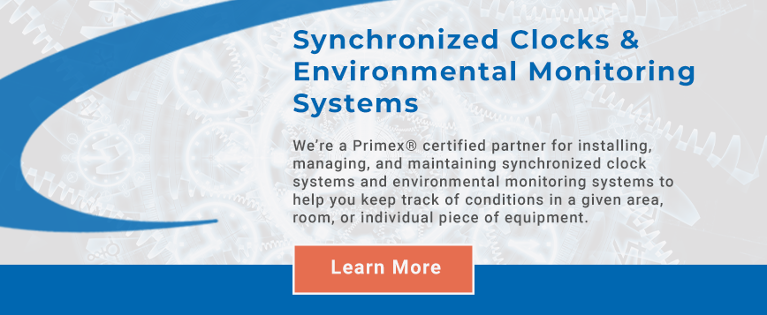We get a lot of questions about the different solutions that Blue Wave Communications offers aside from structured cabling. In particular, many customers wonder what the environmental monitoring systems and synchronized clocks solutions are, and what they’re useful for.
So, here’s a quick FAQ about environmental monitoring and synchronized clocks to help answer some of the basic questions you might have:
What is Environmental Monitoring for Businesses?
Environmental monitoring for businesses (not to be confused with global environmental monitoring) consists of a series of systems that can be used to verify certain conditions within a building, a room, or individual pieces of equipment. The uses of environmental monitoring systems can vary depending on the organization.
What Are Some Uses of Environmental Monitoring Systems?
Businesses with cold storage rooms might use environmental monitoring systems that focus on measuring air temperature and humidity—using thermo-hygrometer sensors to check conditions so stored products don’t spoil. Meanwhile, office environment monitoring systems might use simpler thermometer systems to make sure that office temperatures are being kept in a safe, comfortable range.
Hospitals or research facilities might use environmental monitoring systems that can track air pressure and humidity to ensure that clean rooms or operating rooms maintain the most sterile and safe environment possible. This is because sudden changes in air pressure may indicate problems with a clean room’s seal, while high humidity creates a risk of mold growth—which is bad for any building, let alone one where sterile environments are essential.
What Are the Benefits of Environmental Monitoring?
The benefits of environmental monitoring will vary depending on the application in question. However, some common benefits of these systems include:
- Helping to Reduce Maintenance Costs. Being able to carefully monitor and control both the temperature and humidity in a building can be an excellent way to identify problems sooner and avoid unnecessary maintenance or repair costs. For example, an office environment monitoring system could be used to check for high humidity that indicates mold or moisture intrusion risks while water leak sensors can alert maintenance at the first signs of a leak—allowing for faster remediation that limits the scope of the damage.
- Preventing Product Loss. Similar systems in refrigerators/freezers can detect when temperatures are starting to rise above optimal levels and send out alerts to the proper personnel. This helps businesses prevent inventory loss by allowing product to be moved from the failing freezer/fridge to one that works while repairs are made.
- Improving Employee Health. Environmental monitoring systems specialized for tracking indoor air quality (IAQ) can be incredibly useful for promoting employee health and wellbeing. As noted by the Occupational Safety and Health Administration (OSHA), poor IAQ “has been tied to symptoms like headaches, fatigue, trouble concentrating, and irritation of the eyes, nose, throat, and lungs.” This can negatively impact employee attendance and performance. Being able to track IAQ helps to curtail these problems.
What Are Synchronized Clocks?
Synchronized clocks are a time-keeping solution that can use signals from GPS or network time protocol (NTP) transmitters, or wireless network communications, to constantly self-update to display the correct time on ALL clocks throughout the facility.
What Are the Challenges of Using Synchronized Clocks?
The traditional challenge with GPS/NTP synchronized clocks has been getting a reliable transmitter signal inside of buildings. Meanwhile, frequent update requests on a wireless network connection could clog Wi-Fi routers and even interfere with some electromagnetically sensitive devices such as pacemakers—making them less than ideal for hospital environments.
However, more modern synchronized clock solutions have created a workaround to this problem. Using a spontaneously-generated Bluetooth wireless network, these modern time-keeping solutions send and receive updates once each day—enough to ensure that every clock in the network is accurate to the second, but not so frequent that it impacts your wireless network bandwidth. This minimal communication model also reduces electromagnetic interference to the absolute minimum—making it safer to use around sensitive equipment.
What Are the Uses of Synchronized Clocks?
Many people question the value of using a synchronized clock system in any kind of professional setting. After all, most people have internet clocks on their phones and laptops that provide them accurate time.
However, these systems aren’t always perfectly coordinated (such as if one uses GPS vs NTP vs UTC, personalized “daylight savings” time settings, incorrect time zone registrations, etc.). Additionally, not everyone can whip out their laptop or smartphone just to check the time.
One use case for synchronized clock systems is in healthcare facilities where accurate timekeeping can play an important role in patient care.
Say a patient is administered medication when the clock in the patient room reads 12:30 pm, and has to wait 30 minutes for their body to process the medication before the next phase of treatment can begin. However, the clock in the operating room is five minutes fast. As the patient is called to the room early, the assistant physician administers the next dose of medication too early, leading to complications that cause the patient lasting harm.
This could contribute to a medical malpractice suit—even if the mistimed application of the second medication wasn’t really the root cause of the issue. Had the clocks in both rooms been synchronized to the same system, then the issue could have been avoided.
In less dire circumstances, synchronized clock systems can help keep every employee in an office working on the same time—helping to improve coordination for meetings and other time-sensitive events.
In a school environment, the benefits of having synchronized clocks are relatively self-explanatory considering the numerous bell schedules, lunchtimes, and release times involved—not to mention the reliance on having accurate time for efficient transitions of students, teachers and administrators around these schedules.
Have more questions about environmental monitoring and synchronized clock systems? Reach out to the Blue Wave Communications team to get answers!
